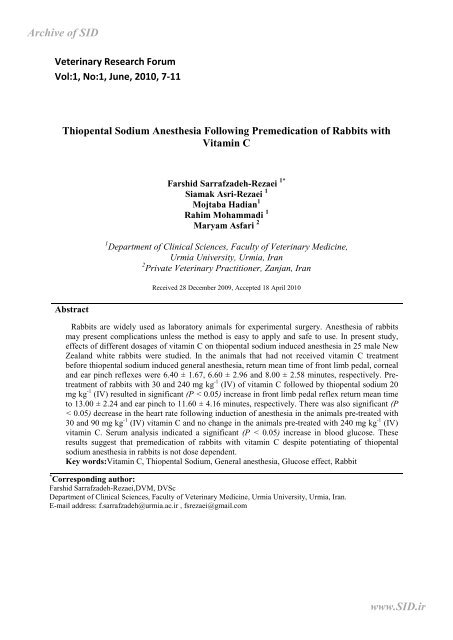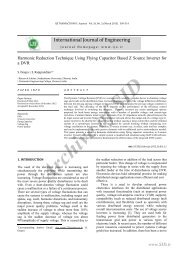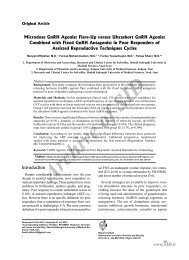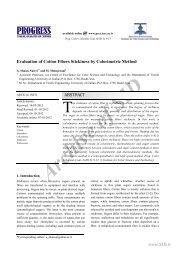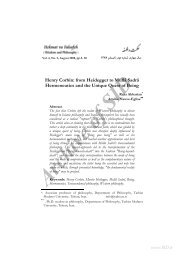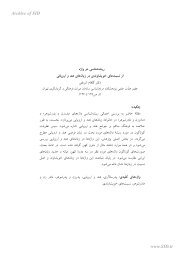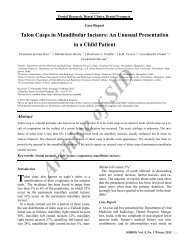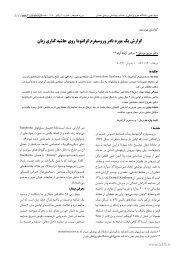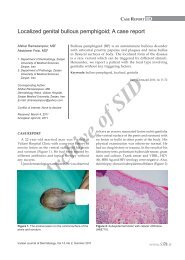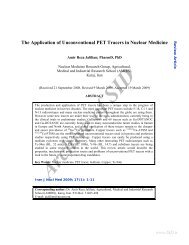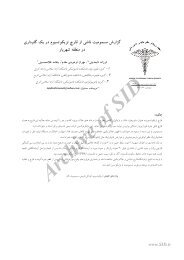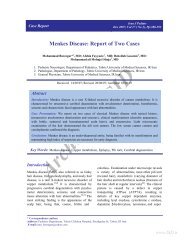thiopental sodium anesthesia following premedication of ... - Sid
thiopental sodium anesthesia following premedication of ... - Sid
thiopental sodium anesthesia following premedication of ... - Sid
Create successful ePaper yourself
Turn your PDF publications into a flip-book with our unique Google optimized e-Paper software.
Archive <strong>of</strong> SID<br />
Veterinary Research Forum<br />
Vol:1, No:1, June, 2010, 7-11<br />
Thiopental Sodium Anesthesia Following Premedication <strong>of</strong> Rabbits with<br />
Vitamin C<br />
Farshid Sarrafzadeh-Rezaei 1*<br />
Siamak Asri-Rezaei 1<br />
Mojtaba Hadian 1<br />
Rahim Mohammadi 1<br />
Maryam Asfari 2<br />
1 Department <strong>of</strong> Clinical Sciences, Faculty <strong>of</strong> Veterinary Medicine,<br />
Urmia University, Urmia, Iran<br />
2 Private Veterinary Practitioner, Zanjan, Iran<br />
Received 28 December 2009, Accepted 18 April 2010<br />
Abstract<br />
Rabbits are widely used as laboratory animals for experimental surgery. Anesthesia <strong>of</strong> rabbits<br />
may present complications unless the method is easy to apply and safe to use. In present study,<br />
effects <strong>of</strong> different dosages <strong>of</strong> vitamin C on <strong>thiopental</strong> <strong>sodium</strong> induced <strong>anesthesia</strong> in 25 male New<br />
Zealand white rabbits were studied. In the animals that had not received vitamin C treatment<br />
before <strong>thiopental</strong> <strong>sodium</strong> induced general <strong>anesthesia</strong>, return mean time <strong>of</strong> front limb pedal, corneal<br />
and ear pinch reflexes were 6.40 ± 1.67, 6.60 ± 2.96 and 8.00 ± 2.58 minutes, respectively. Pretreatment<br />
<strong>of</strong> rabbits with 30 and 240 mg kg -1 (IV) <strong>of</strong> vitamin C followed by <strong>thiopental</strong> <strong>sodium</strong> 20<br />
mg kg -1 (IV) resulted in significant (P < 0.05) increase in front limb pedal reflex return mean time<br />
to 13.00 ± 2.24 and ear pinch to 11.60 ± 4.16 minutes, respectively. There was also significant (P<br />
< 0.05) decrease in the heart rate <strong>following</strong> induction <strong>of</strong> <strong>anesthesia</strong> in the animals pre-treated with<br />
30 and 90 mg kg -1 (IV) vitamin C and no change in the animals pre-treated with 240 mg kg -1 (IV)<br />
vitamin C. Serum analysis indicated a significant (P < 0.05) increase in blood glucose. These<br />
results suggest that <strong>premedication</strong> <strong>of</strong> rabbits with vitamin C despite potentiating <strong>of</strong> <strong>thiopental</strong><br />
<strong>sodium</strong> <strong>anesthesia</strong> in rabbits is not dose dependent.<br />
Key words:Vitamin C, Thiopental Sodium, General <strong>anesthesia</strong>, Glucose effect, Rabbit<br />
* Corresponding author:<br />
Farshid Sarrafzadeh-Rezaei,DVM, DVSc<br />
Department <strong>of</strong> Clinical Sciences, Faculty <strong>of</strong> Veterinary Medicine, Urmia University, Urmia, Iran.<br />
E-mail address: f.sarrafzadeh@urmia.ac.ir , fsrezaei@gmail.com<br />
www.SID.ir
Archive <strong>of</strong> SID<br />
F.Sarrafzadeh-Rezaei et al. /Veterinary Research Forum. 1(June, 2010) 7-11<br />
Introduction<br />
Rabbit has gained an increased<br />
popularity among urban families as a<br />
domestic pet. A safe anesthetic method is<br />
therefore needed both for surgeons<br />
undertaking research and for practicing<br />
veterinarians. Especially in veterinary<br />
practice <strong>anesthesia</strong> <strong>of</strong> the rabbit may<br />
present problems unless the method is easy<br />
to use and efficient and safe to use.<br />
Vitamin C possesses properties <strong>of</strong><br />
modulating the central nervous system<br />
either physiologically and<br />
pharmacologically. There are some reports<br />
<strong>of</strong> insomnia and anxiety implicating<br />
vitamin C is an important regulator <strong>of</strong><br />
mood and behavior . 1,2 Vitamin C appears<br />
to be similar in structure to glucose and<br />
many animals convert the intermediate<br />
gluconic acid to vitamin C. Hence,<br />
<strong>premedication</strong> with vitamin C in <strong>thiopental</strong><br />
<strong>sodium</strong> <strong>anesthesia</strong> may promote a<br />
phenomenon called glucose effect which<br />
prolongs recovery from <strong>anesthesia</strong>. 3 This<br />
study was designed to determine the<br />
effects <strong>of</strong> different dosages <strong>of</strong> vitamin C<br />
on <strong>thiopental</strong> <strong>sodium</strong> <strong>anesthesia</strong> in rabbits.<br />
High doses <strong>of</strong> vitamin C has been reported<br />
to induce sleep disturbances, headache and<br />
gastrointestinal disturbances . 4,5 Combined<br />
effects <strong>of</strong> stress and <strong>anesthesia</strong> can result<br />
in cardiopulmonary arrests. Rabbits are<br />
prone to be easily stressed by improper<br />
preoperative handling and/or induction <strong>of</strong><br />
<strong>anesthesia</strong>. 6 Recovery from <strong>anesthesia</strong> is<br />
<strong>of</strong>ten slow particularly <strong>following</strong> use <strong>of</strong><br />
barbiturates in rabbits. 7 This study was<br />
designed to determine the effects <strong>of</strong><br />
vitamin C on <strong>thiopental</strong> <strong>sodium</strong> <strong>anesthesia</strong><br />
in rabbits<br />
Materials and Methods<br />
Twenty-five adult (8 to 10 months old)<br />
male New Zealand white rabbits weighing<br />
2.00 ± 0.25 kg were included in this study.<br />
They were divided into five groups (A, B,<br />
C, D and E) <strong>of</strong> five rabbits each, randomly.<br />
They were kept in a controlled<br />
environment (room temperature, 18-21 °C;<br />
humidity, 55-65%) and were fed a<br />
standard commercial pellet diet (Niro<br />
Sahand Co., Tabriz, Iran) to meet all<br />
necessary minerals and vitamins<br />
requirements (including Vitamin C) and<br />
green hay and housed in animal house <strong>of</strong><br />
Veterinary Teaching Hospital <strong>of</strong> Faculty <strong>of</strong><br />
Veterinary Medicine, Urmia, Iran. Tap<br />
water was provided ad libitum. The rabbits<br />
underwent daily standard clinical<br />
examination to monitor their health. They<br />
were acclimatized for two weeks before<br />
the experiment started. The procedures<br />
were carried out based on the guidelines <strong>of</strong><br />
the Ethics Committee <strong>of</strong> the International<br />
Association for the Study <strong>of</strong> Pain. 8 The<br />
experimental procedures were approved by<br />
the clinical sciences committee <strong>of</strong> Faculty<br />
<strong>of</strong> Veterinary Medicine, Urmia University,<br />
with reference number 923.<br />
Anesthetic protocol. The vital<br />
parameters such as body temperature,<br />
heart and respiratory rates were recorded<br />
before each anesthetic protocol. Marginal<br />
vein <strong>of</strong> rabbit ear was catheterized using<br />
local <strong>anesthesia</strong>. Blood samples were<br />
obtained before and after each <strong>anesthesia</strong>,<br />
centrifugated 5000 rpm for ten min and<br />
taken to laboratory for serum glucose,<br />
calcium and phosphorus assay. Animals in<br />
group A (control) received normal saline<br />
the same volume as <strong>thiopental</strong> <strong>sodium</strong>, and<br />
group B received no treatment before<br />
<strong>thiopental</strong> <strong>sodium</strong> induced general<br />
<strong>anesthesia</strong>. Rabbits <strong>of</strong> groups C, D and E<br />
received 30, 90 and 240 mg kg -1 , IV <strong>of</strong><br />
vitamin C (Vitamin C 500 mg, Osveh<br />
Pharmaceutical Co. Tehran, Iran),<br />
respectively. Five minutes after the<br />
<strong>premedication</strong> animals underwent general<br />
<strong>anesthesia</strong> using 2.5% <strong>thiopental</strong> <strong>sodium</strong><br />
(Specia Rhone-Poulenc Rorer, Paris,<br />
France), (20 mg kg -1 , IV). Immediately<br />
after induction front limb pedal, corneal,<br />
palpebral and ear pinch reflexes return<br />
mean time were assessed and a baseline<br />
recording <strong>of</strong> vital parameters obtained for<br />
8<br />
www.SID.ir
Archive <strong>of</strong> SID<br />
F.Sarrafzadeh-Rezaei et al. /Veterinary Research Forum. 1(June, 2010) 7-11<br />
a two minute period. The time animal<br />
showing ability to sit unaided on its<br />
sternum was recorded.<br />
Statistical analysis. Mean and standard<br />
error were used in analyzing the data.<br />
Changes in control and experimental<br />
values were compared for statistical<br />
significance using ANOVA. Values <strong>of</strong> P <<br />
0.05 were considered significant.<br />
Results<br />
In rabbits <strong>of</strong> group B front limb pedal,<br />
corneal and ear pinch reflexes' return mean<br />
time were 6.40 ± 1.67, 6.60 ± 2.96 and<br />
8.00 ± 2.58 minutes, respectively. Pretreatment<br />
<strong>of</strong> rabbits with 30 and 240 mg<br />
kg -1 IV <strong>of</strong> vitamin C followed by<br />
<strong>thiopental</strong> <strong>sodium</strong> resulted in significant (P<br />
< 0.05) increase in front limb pedal and<br />
ear pinch reflexes return mean time in<br />
animals <strong>of</strong> groups C and E, respectively<br />
(Table 1).Administration <strong>of</strong> vitamin C<br />
prior to <strong>thiopental</strong> <strong>sodium</strong> treatment also<br />
significantly decreased heart rate in<br />
animals <strong>of</strong> groups C and D, P = 0.0002<br />
and P = 0.004, respectively. Changes in<br />
those <strong>of</strong> group E were not significant (P =<br />
0.49). There was no significant difference<br />
in temperature and respiratory rate <strong>of</strong> any<br />
groups (P > 0.05). Duration <strong>of</strong> <strong>anesthesia</strong><br />
increased in animals <strong>of</strong> groups C and E,<br />
and decreased in group D. Premedication<br />
<strong>of</strong> rabbits with vitamin C prior to<br />
administration <strong>of</strong> <strong>thiopental</strong> <strong>sodium</strong><br />
(groups C, D and E) gave rise to<br />
significant (P < 0.05) increase <strong>of</strong> serum<br />
glucose when compared to the control and<br />
<strong>thiopental</strong> <strong>sodium</strong> group only (groups A<br />
and B). However, serum levels <strong>of</strong> calcium<br />
and phosphorus didn’t change significantly<br />
(P > 0.05) (Table 2).<br />
Table 1. Changes in reflexes return mean time (Mean ± SD)<br />
Group<br />
Reflexes<br />
front limb pedal (min)<br />
Corneal reflex (min)<br />
Ear pinch reflex (min)<br />
B<br />
6.40 ± 1.67 †<br />
6.60 ± 2.96 †<br />
8.00 ± 2.58 †<br />
C<br />
13.00 ± 2.24 ‡<br />
3.03 ± 3.00 †‡<br />
N/A<br />
D<br />
10.40 ± 1.67 †‡<br />
3.00 ± 1.41 †‡<br />
N/A<br />
E<br />
10.60 ± 4.50 †‡<br />
2.20 ± 1.95 ‡<br />
11.60 ± 4.16 ‡<br />
Values with different symbols († and ‡) indicating significant difference at P < 0.05.<br />
N/A: Not available<br />
9<br />
www.SID.ir
Archive <strong>of</strong> SID<br />
F.Sarrafzadeh-Rezaei et al. /Veterinary Research Forum. 1(June, 2010) 7-11<br />
2. Sauberich HE. Pharmocology <strong>of</strong> vitamin<br />
C. Annu Reev Nutr 1994; 14: 371-391.<br />
3. Thurmen JC, Tranquilli WJ, Benson GJ.<br />
Lumb & Jones’ Veterinary Anesthesia<br />
(3 Ed). .Williams & Wilkins, Baltimore,<br />
1996; pp 217<br />
4. Gregg DA, Olson LD. The use <strong>of</strong><br />
ketamine hydrochloride asan<br />
anaesthetic for raccoon. J Wildl Dis<br />
1975; 11: 335-337.<br />
5. Laurence DR, Bennett PN, Brown MJ.<br />
ClinicalPharmacology, 8th ed.<br />
Churchill Livingstone,London, 1997;<br />
383-384,<br />
6. Flecknell P. Laboratory animal<br />
<strong>anesthesia</strong>. Academic Press, London,<br />
1992; 88-889<br />
7. Elsa A, Ubandawaki S. Ketamine<br />
<strong>anesthesia</strong> <strong>following</strong> <strong>premedication</strong> <strong>of</strong><br />
rabbits with vitamin C. J. Vet. Sci.<br />
2005; 6: 239-241.<br />
8. Zimmermann M. Ethical guidelines for<br />
investigations <strong>of</strong> experimental pain in<br />
conscious animals. Pain 1983;24:109-<br />
110.<br />
9. Gurnani A, Sharma PK, Rautela RS, et<br />
al. Analgesia for acute musculoskeletal<br />
trauma; Low- dose subcutaneous<br />
infusion <strong>of</strong> ketamine. Anaesth Intensive<br />
Care 1996; 24: 32-36.<br />
10. Hemila H. Vitamin C and common<br />
cold. Br J Nutr 1992; 67: 3-6.<br />
11. Peters M, Strother A. A study <strong>of</strong> some<br />
possible mechanisms by which glucose<br />
inhibits ground metabolism in vivo and<br />
in vitro. J Pharmacol Exp Ther 1972;<br />
180: pp 151.<br />
11<br />
www.SID.ir


